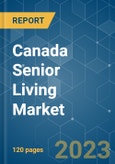Senior living facilities were significantly impacted by the COVID-19 pandemic in Canada. During the first wave of the pandemic (March through August 2020), residents of nursing and senior homes accounted for more than 80% of all reported COVID-19 deaths. As of early March 2021, reports indicated that nursing and senior homes accounted for the greatest proportion of outbreak-related cases and deaths, representing about 7% of all cases and more than 50% of all deaths. Residential care facilities are potentially at higher risk of infection, given the unavoidable close contact between staff and residents.
The population of seniors aged 75 years and older in Canada is expected to grow by 111.2% between 2014 and 2034, while the total population of Canada is only expected to increase by 19.1% over the same period. This trend has captured the attention of investors and real estate developers, resulting in increased capital flows and construction in the seniors housing and long-term care sector in Canada.
Key Market Trends
Rise in Investments for Senior Housing
In 2021, investments in Canadian senior housing were recorded at around CAD 2 billion, higher than the previous year, i.e., only CAD 1.1 billion. Most of the Canadian senior housing market participants are integrated owners/operators. These companies devoted the majority of their focus on operations in 2020 rather than pursuing new investments. Following a quiet start to 2021, investment market activity picked up in the second half of the year, marked by major investments by Blackstone, Ventas, and Harrison Street. As a result, the total dollar volume of Canadian senior housing transactions in 2021 nearly doubled the volume of transactions that closed in 2020. Canadian senior housing transaction activity and overall momentum will continue to increase in 2022.Increase in Rents for Senior Housing in Canada
The number of residents decreased or only moderately increased, leading to higher vacancy rates. The weak demand could be the reluctance of households to move into senior residences during the COVID-19 pandemic. Despite the increase in vacancy rates, rents increased in all provinces due to the rising cost of living and other essentials. Quebec posted the highest capture rate in the country, despite a decrease. About 17% of seniors aged 75 and older lived-in senior residences in 2021. This proportion varied between 5.0% and 10% in other provinces across the country.Average rents in British Columbia across all unit types increased from CAD 3,364 to CAD 3,541 in 2021, while average rents in Alberta rose to CAD 3,404 in 2021. While in a few provinces, rents delined, such as in Manitoba, Prince Edward Island, Newfoundland, and Labrador.
Competitive Landscape
Canada’s senior living market is relatively fragmented, with the presence of local and small developers and few branded players. Higher competition exists among the fragmented players. Some of the major players in the market include Chartwell Master Care LP, Sienna Senior Living, Atria Senior Living, Sunrise Senior Living LLC, and All Seniors Care Living Centers.Additional Benefits:
- The market estimate (ME) sheet in Excel format
- 3 months of analyst support
This product will be delivered within 2 business days.
Table of Contents
Companies Mentioned (Partial List)
A selection of companies mentioned in this report includes, but is not limited to:
- Chartwell Master Care LP
- Sienna Senior Living
- Atria Senior Living
- Sunrise Senior Living LLC
- All Seniors Care Living Centers
- Berwick Retirement Communities
- Verve Senior Living
- Signature Retirement Living
- A Place for Mom
- Ross Place Seniors Community*










